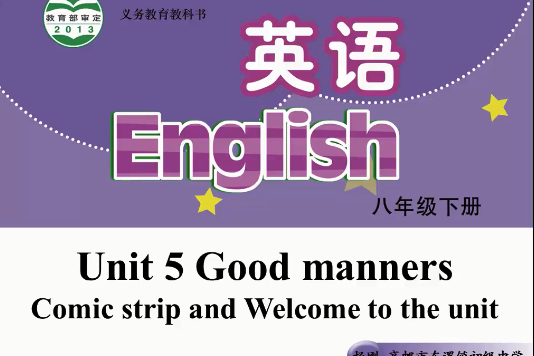《Unit 5 Good manners Welcome to the unit》是車邏中學提供的微課課程,主講教師為楊剛。
基本介紹
- 外文名:Unit 5 Good manners Welcome to the unit
- 提供學校:車邏中學
- 類別:微課
- 授課教師:楊剛
課程簡介,設計思路,
課程簡介
本課時是本單元的第一課時,主要功能是引出本單元話題 Good manners,同時通過生動的動畫演示以及真實的對話活動等激發學生學習的積極性和興趣點,本微課對課本知識點進行簡要梳理的同時也圍繞主題作了適當的拓展延伸,讓學生在觀看微課的過程中也受到了有效的文明行為習慣的教育。
設計思路
《英語》(八年級下冊) Unit 5 Good manners Comic strip and Welcome to the unit 高郵市車邏鎮初級中學 楊剛 I. Teaching aims and learning objectives By the end of the lesson, students should be able to: 1. know different kinds of knowledge about manners; 2. talk about how to act politely in public; II. Teaching contents 1. New words and phrases: manners, eh, politely, litter, tap, run, pick, obey, queue, turn, cut in (on sb/sth), drop litter everywhere, leave the tap running, obey traffic rules, queue for your turn 2. New structures: We should/shouldn’t …. We can/can’t …. Don’t/Always …. You are old enough to learn about manners. You’re never too old to learn. III. Focus of the lesson and predicted area of difficulty Talk about how to act politely in public in English. IV. Teaching procedures Comic strip Step 1 Lead-in T: Hello, everyone. Today we’ll learn Comic strip and Welcome to the unit of Unit 5. Look at the pictures. Eddie is looking at the empty fridge. He is hungry. What does he think about? 【設計意圖:利用卡通小狗Eddie饞嘴的特點設定情境,圖片導入漫畫內容,簡潔明了。激發學生的學習興趣。】 Step 2 Presentation 1. Watch a video T: Now let’s watch a video. 2. Think and answer T: There are three questions for you. Please think and answer. (1) Who is teaching manners? (2) What does Eddie teach Hobby? (3) What does Eddie really want from Hobo? T: Can you understand the two sentences? 3. Read and act T: Now read the dialogue in pairs and act it out. 【設計意圖:通過觀看教學視頻,討論視頻內容,分角色朗讀對話,表演對話,引導學生思考Eddie和Hobo的行為,為學習正確的行為習慣做好鋪墊。】 Welcome to the unit Step 1 Lead-in See some pictures. T: Let’s see some pictures and think if they did right. Step 2 Presentation 1. Play stickers T: OK, what did you see in these pictures? Yes, some bad manners. Look at these stickers. What are they about? Manners. Can you stick them and give reasons? 【設計意圖:設定貼貼圖活動,幫助學生將不同的禮儀行為歸類,通過圖片直觀地了解禮儀,激發興趣。】 2. Look and learn T: I think you all know what to do in your daily life. It’s time for me to check that. First, look at the pictures. Can we ...? I’m afraid not. What should we do? We should always …. We shouldn’t …. T: Look at the girl. Can she …? Of course not. What should she do? She should …. T: What’s this? It’s a tap. Is it good manners to … after use? I’m afraid not. What … then? Always … after use. Anything else? Try to …. T: Look! What are they doing? They are following the traffic rules. Here follow means obey. Can they …? … What should they do then? … T: What about this picture? What are they doing? They are waiting for their turn. Here wait for means queue. What about this one? They are jumping the queue. Do we have to … in our school dining hall? Yes, it’s polite to …. … impolite …. 【設計意圖:利用對話形式討論教材六幅圖片,學習公共場合的禮儀,輸入對話短語和句型,為後面的兩人討論做好鋪墊。】 Step 3 Practice 1. Right or wrong T: Look at these pictures. Are these people doing right or wrong things? Throw the board into the dustbin if they do wrong things. T: Picture 1 What is the boy doing? He is obeying traffic rules. It’s right. Picture 2 What is the girl doing? She is picking flowers in the park. It’s wrong. Picture 3 What is the boy doing? He is leaving the tap running. It’s wrong. Picture 4 What are they doing? They are keeping quiet in the library. It’s right. Picture 5 What are they doing? They are dropping litter everywhere. It’s wrong. Picture 6 What are they doing? They are queuing for their turn. It’s right. 【設計意圖:呈現課本六幅圖片,讓學生判斷文明與不文明行為,培養他們的是非觀。】 2. Look and match T: Please match the pictures with the phrases. 【設計意圖:設計圖片和文字搭配練習,幫助學生進一步了解禮儀行為。】 3. Spot the Odd One Out T: Now let’s play a game. Spot the Odd One Out. Which is the odd one out? (Click A) Sorry! Try again. (Click C) That’s correct. It’s a picture of a library, and all the other items are pictures of books. T: (Click D) That’s correct. It is table manners, and all the other items are manners in the library. T: (Click C) Sorry! Try again. (Click D) Sorry! Try again. (Click A) That’s correct. It’s good manners to put the books back after reading, and all the other items are bad manners. T: (Click B) Sorry! Try again. (Click D) Sorry! Try again. (Click E) That’s correct. It’s bad manners to write in the books, and all the other items are good manners. 【設計意圖:針對圖書館行為,利用圖片和文字兩種方式設計找不同遊戲,並指出其理由,為下面學習對話做好過渡,活躍氣氛,調動學生學習積極性。】 Step 4 Listening & Speaking 1. Listen and complete T: Amy and her cousin Shirley are discussing what they should and should not do in the library. Listen to their dialogue and complete the form. 【設計意圖:設計表格,引導學生帶著問題去聽對話,了解圖書館行為規範。前面環節的鋪墊降低了本部分填表的難度,學生比較容易得出答案。】 2. Discussion T: Work in pairs. Discuss what we should and should not do in a public place. Make a new dialogue. Here are some useful expressions for you. 【設計意圖:兩人討論公共場所的文明與不文明行為,鼓勵學生用本節課所學的句型編造對話,既鞏固了本課的重點句型又鍛鍊了口頭表達能力。】 V. Homework 1. Discuss manners in public places with your classmates. 2. Write as many slogans on good manners as you can. 3. Preview Reading.

